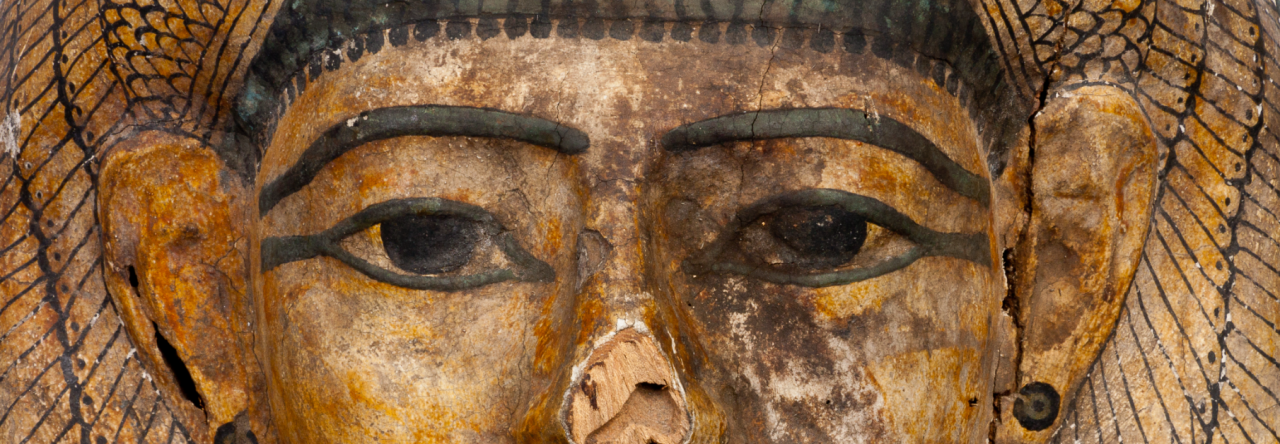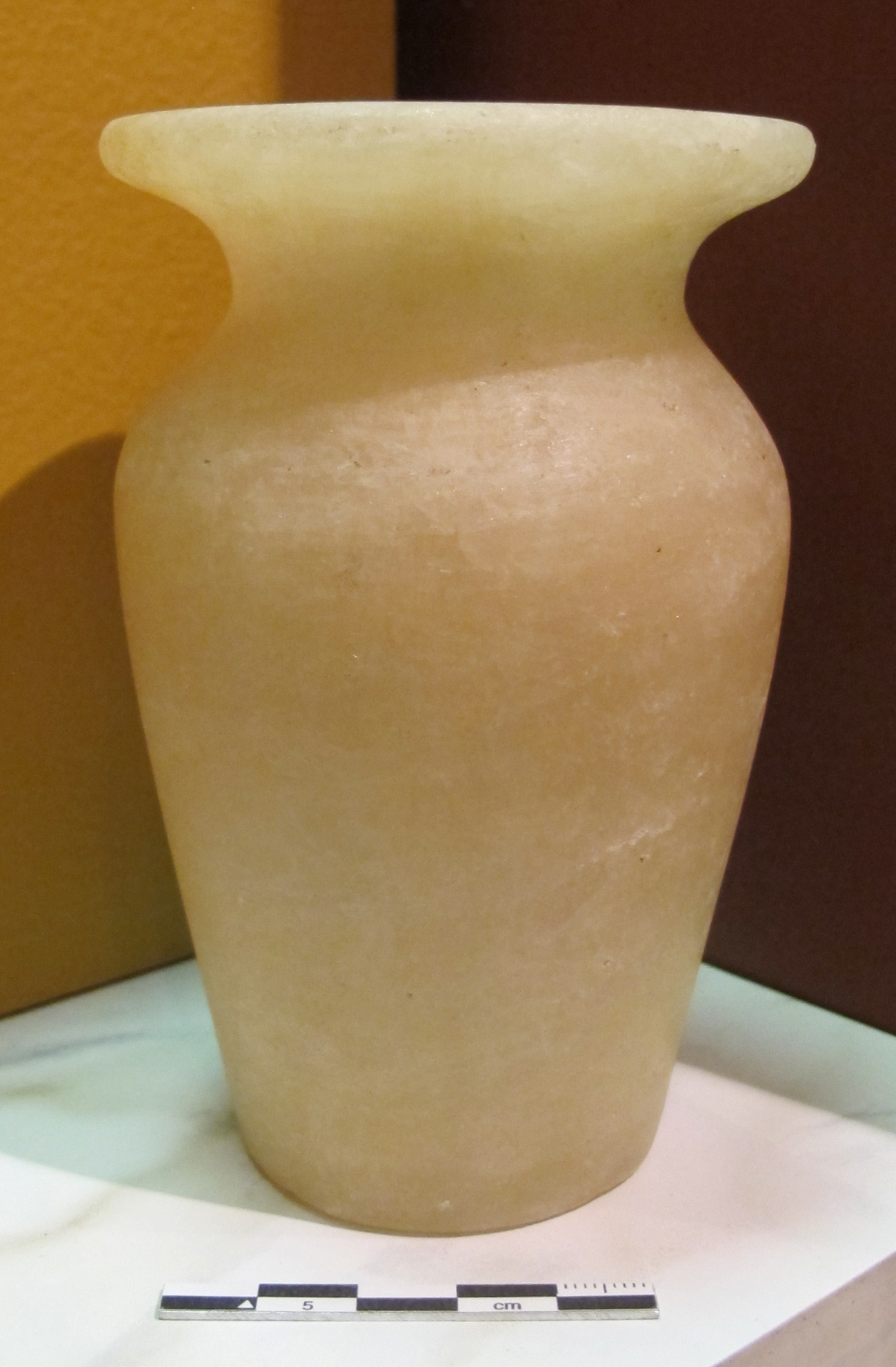AWG1980.01.02
Egyptian
Early Dynastic period or later (after 2925 BCE), probably Old KingdomMaterial: Egyptian alabaster - calcium carbonate
Technique: Carved with the use of hand drill to create a center opening - no evident traces of machine manufacturing
Weight: 476g
Dimensions: 11.35 cm high, 5.1 cm diameter at base, 7.3 cm diameter at widest point, 4.6 cm diameter at thinnest point, 7.3 cm diameter at mouth, 4.3 cm diameter opening at top
Condition: Good to excellent, with minimal chipping or other damage
Provenance: Unknown, said to be from Egypt
Source/donor: Estate of May Keller
Date of acquisition: 1980
Research by: Madison Phillips, ’23
Detailed description:
Small jar with flared mouth and broad flat rim, tapered neck, and flat base. Light pink, translucent stone. Symmetrical body with no visible decoration (bands result from natural coloration of stone).
Comparanda:
For the general shape and design, see Egyptian Alabaster at the Heart Museum of Anthropology (No. 5-11383). For comparable jar shape and flat rim, though with more squat profile, see jars from the Brooklyn Museum (No. 13.1031) and Metropolitan Museum (No. 35.3.22a, b). Similar drilling striations occur on the interior of an Old Kingdom jar in the Hearst Museum, Berkeley (No. 6-10018; Hester and Heizer 1981, fig. XXI). Another jar in the Hearst collection (No. 5-11386; Hester and Heizer 1981, fig. XVII-2) offers a good parallel for the size of our jar and the shape of the mouth and rim.
Discussion:
This small jar is composed of Egyptian alabaster, also known as calcite alabaster, which closely resembles genuine gypsum alabaster. Egyptians began carving this stone into vessels and other objects in the Early Dynastic period. Alabaster was widely used and prized by the ancient Egyptians since it was easy to work with and was also thought worthy of being possessed by the gods, perhaps because of its translucence. To make a vase like this one, a piece of worked flint or sandstone would be attached to the bottom of a post with handles affixed to the top to act as a borer, which would then be spun to carve the center chamber of the vessel. This method of carving the vessel creates the characteristic ridges seen inside many alabaster jars. Such jars could have been used as storage for every day or burial items. The small size of our jar suggests that it may have been used to hold perfume or oil.
The high value Egyptians placed on a healthy, beautiful appearance led to the development of effective sunblocks, moisturizers, oils, and cosmetics. For instance, oils mixed with jasmine kept the sun from damaging the skin, animal fats were used as moisturizers, and honey was used as a sweet, aromatic moisturizer. The iconic eye makeup we associate with ancient Egypt, which can also be seen on the lid of Ti-Ameny-Net’s coffin, was a mixture of oil and kohl. This style of makeup was considered stylish, absorbed light from the harsh sun to prevent glare (much like modern football players’ eyeblack), was thought to symbolize holiness, and had significant religious importance. Kohl and other cosmetic creams were stored in alabaster vessels like this one and often buried alongside the dead.
Bibliography:
“Egyptian Alabaster.” CAMEO, Museum of Fine Arts, Boston. 2020. http://cameo.mfa.org/wiki/Egyptian_alabaster.
Hester, T. R., & Heizer, R. F. (1981). Making stone vases: Ethnoarchaeological studies at an alabaster workshop in Upper Egypt (2nd ed., Vol. 1). The International Institute for Mesopotamian Area Studies.
Jacknis, Ira. “Egyptian Alabaster.” Phoebe A. Hearst Museum of Anthropology, November 15, 2017. https://hearstmuseum.berkeley.edu/egyptian-alabaster/.
Kuhlman, Katie L. “The Contents and Significance of Egyptian Alabaster Jars,” May 16, 2020.
Samuel, Alan, Peter Dorman, Edward Wente, Alan Bowman, and John Baines. “The Predynastic and Early Dynastic Periods.” Encyclopædia Britannica. Encyclopædia Britannica, inc., July 2, 2007. https://www.britannica.com/place/ancient-Egypt/The-Predynastic-and-Early-Dynastic-periods.
Totelin, Laurence. “Cleopatra's Eye: The Significance of Kohl in Ancient Egypt.” The Recipes Project, November 27, 2018. https://recipes.hypotheses.org/12837.
van der Plas, Dirk. “Alabaster.” The Global Egyptian Museum | Alabaster, 2006. http://www.globalegyptianmuseum.org/glossary.aspx?id=48#:~:text=From%20the%20Early%20Dynastic%20Period,of%20limestone%20%2D%20calcium%20carbonate.


